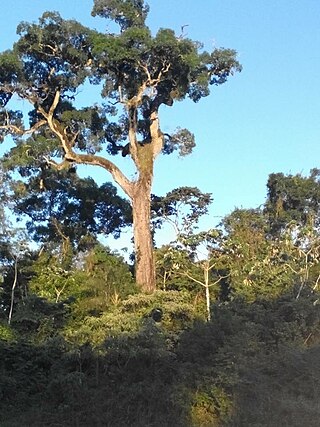
Royal Botanic Gardens, Kew is a non-departmental public body in the United Kingdom sponsored by the Department for Environment, Food and Rural Affairs. An internationally important botanical research and education institution, it employs 1,100 staff. Its board of trustees is chaired by Dame Amelia Fawcett.

Carl Friedrich Philipp von Martius was a German botanist and explorer.

Antonio José Cavanilles was a leading Spanish taxonomic botanist of the 18th century. He named many plants, particularly from Oceania. He named at least 100 genera, about 54 of which were still used in 2004, including Dahlia, Calycera, Cobaea, Galphimia, and Oleandra. The standard author abbreviation Cav. is used to indicate this person as the author when citing a botanical name.

Heinrich Gustav Adolf Engler was a German botanist. He is notable for his work on plant taxonomy and phytogeography, such as Die natürlichen Pflanzenfamilien, edited with Karl A. E. von Prantl.

Aspidosperma cylindrocarpon is a timber tree native to Brazil, Paraguay, Bolivia, and Peru. It is common in Atlantic Forest, Cerrado and Pantanal vegetation of Brazil. This plant is cited in Flora Brasiliensis by Carl Friedrich Philipp von Martius. In addition, it is useful for beekeeping.

Aspidosperma parvifolium is a timber tree native to Brazil, which is typical of Atlantic Forest, Cerrado, Caatinga, and Pantanal vegetation. This plant is cited in Flora Brasiliensis by Carl Friedrich Philipp von Martius. In addition, it is useful for beekeeping.

Aspidosperma polyneuron is a timber tree native to Brazil, Colombia, Peru, Argentina, and Paraguay. It is common in Atlantic Forest vegetation. In addition, it is useful for beekeeping.

Aspidosperma subincanum is a timber tree native to Brazil and Bolivia. It is common in Cerrado vegetation in Brazil. It was first described by Carl Friedrich Philipp von Martius in 1838.

Aspidosperma tomentosum is a timber tree native to Brazil, Bolivia, and Paraguay. It is common in of Cerrado vegetation in Brazil. It was first described by Carl Friedrich Philipp von Martius.
Aspidosperma olivaceum is a timber tree native to Southeast Brazil. It is common in Atlantic Forest, Cerrado, Caatinga, and Pantanal vegetation.

Apeiba tibourbou is a tree native to Caatinga and Cerrado vegetation in Brazil, and Costa Rica. It is used as an alternative fiber crop to make paper. It is found in Mexico, Central America, and the northern part of South America.

The Caatinga enclaves moist forests is an ecoregion of the Tropical moist forests Biome, and the South American Atlantic Forest biome. It is located in northeastern Brazil.

Aspidosperma megalocarpon is a species of plant in the family Apocynaceae. It can be found in Belize, Colombia, Ecuador, El Salvador, Guatemala, Honduras, Mexico, Nicaragua, Panama, Suriname, Venezuela, and NW Brazil.

Strophocactus brasiliensis, synonym Pseudoacanthocereus brasiliensis, is a species of plant in the family Cactaceae. It is endemic to Brazil. Its natural habitats are subtropical or tropical dry forests and hot deserts. It is threatened by habitat loss.

Aspidosperma spruceanum is a species of flowering plant in the genus Aspidosperma. It is native to Brazil, Bolivia, Peru, and the Guianas.

Cereus jamacaru, known as mandacaru or cardeiro, is a cactus native to central and eastern Brazil. It often grows up to 6 metres high.

Libidibia is a genus of flowering plants in the family Fabaceae. It includes seven species of trees and shrubs native to the tropical Americas, ranging from northern Mexico to northern Argentina. Typical habitats include seasonally-dry tropical forest and scrub, thorn forest, and savanna woodland. It belongs to the subfamily Caesalpinioideae.
















